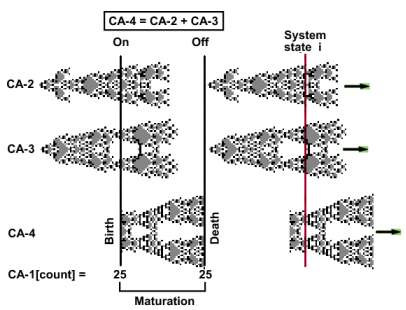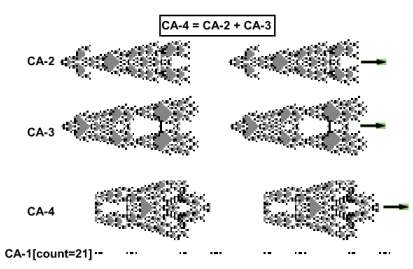 |
Process interaction-1
The previous experiment demonstrated two
kinds of process interaction: One time interaction, and continual
interaction. The present experiment
illustrates other interaction modes. We start with a four CA
system controlled by the stem process (CA-1). Whenever CA-1[count]
= 25, it triggers a {CA-2, CA-3} interaction (computation), During
the first {CA-2, CA-3} interaction, CA-4 was created, whereupon it
started evolving (maturing). It then split into two sub-processes,
and when CA-1[count]
became 25 CA-4 was killed.
 |
In the next experiment {CA-2, CA-3}, interaction (computation) was activated whenever CA-1[count] was 23 (marked by black dots). Between these events, CA-4 evolved on its own.
 |
Process and system computation
The black lines in the first image mark the computation (interaction) of the entire system, including
the stem process which is not shown. The system proceeds from left to
right. Each process continually computes its next state, which is called
here process computation . Most
states do not interact,
like the one marked by the red line (system state = i). Two interacting
states, or system computations are
marked by black lines.
Although the processes are depicted here discretely, in the model they are
joined together. Each system state consists of a string of numbers
which are updated by process computations. If following this update some
processes interact, the procedure
is called here system computation. In the present example system computation
followed the addition rule: CA-4 = CA-2 + CA-3. which was triggered by
the stem process.
This rule is hardwired into
the stem process and triggered when its cell count is 25. By setting a different triggering condition,
stem process may activate the addition rule more often, like in
the second experiment. When turning off its trigger, the system stops
computing, and becomes isolated. It
may be aroused again by an environmental stimulus, which triggers a computation
conceived by us (the observer), as response.
CA-4=CA-2+CA-3 may be regarded as system gene, stored
in the stem process, which when activated is translated into its appropriate
phenotype. In this
context, CA-4=CA-2+CA-3 is not an equation but an option.